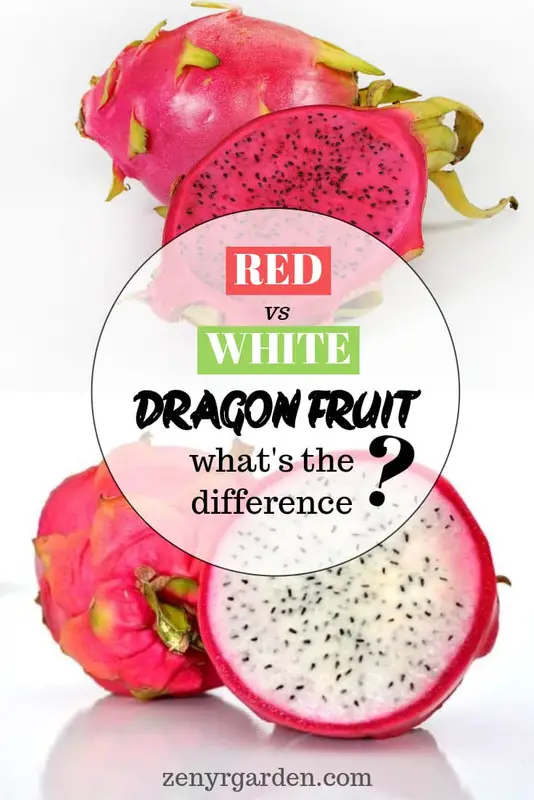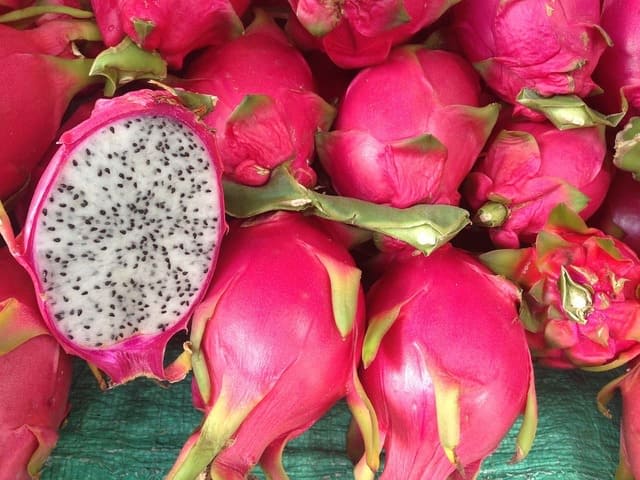To tell the difference between the red & white dragon fruits (even before peeling the fruit), we can look at their scales, flowers & sometimes branches.
Here are the differences we've observed:
#1. Scales (or Ears)
Scales or ears are the little triangles around the dragon fruit body. The red (sometimes purple and pink) dragon fruits tend to have more curvy, green and thick scales.
/all-around-the-red-dragon-fruit.jpg)
Is this a natural phenomenon? Not entirely though. In some markets, farmers beautify these scales by hand-curving them, making the scales more curvy, greener in color and thicker than they normally would be.
The curvy, thicker scales are to increase the attraction value for the red variety, which many folks find more flavorful than the white.
The thickness can also prevent broken scales when the fruits reach the end consumers. When let grown naturally, the scales usually grow out straighter and thinner.
Here are some hand-curved vs natural straight scales:
/red-dragon-fruit-appearance.jpg)
/natural-uncurved-dragon-fruit.jpg)
So when you see dragon fruits with super curvy ears, you may know they may have been hand-curved and they're more likely the red variety.
The whites tend to have wider, further-apart and fewer ears. Whereas the reds have darker, narrower, and more scales:
/wide-scales-white-dragon-fruits.jpg)
/red-dragon-fruit-scale-skin.jpg)
Secondly, the flowers will give us a hint:
#2. Flower Margins & Tips
The red variety's flower tips are more reddish whereas the white variety's have a lighter red and sometimes they are green or yellow.
/red-white-flower-tip.jpg)
Despite this difference, both varieties produce white, fragrant flowers.
Comparing the two, their branches also look quite different:
#3. Branches
It can be a bit hard to tell red from white dragon fruits just by looking at the branches. Overall, the red-flesh varieties seem to have some more thorns on the branches than the white ones.
For some red varieties, they have this distinctive shape of a braid or waves. The Sin Espinas & Bien Hoa Red have this sort of wavy branch shape. They look something like this:
/branch-shape-red-dragon-fruit.jpg)
Some other red ones have super thorny branches. In comparison, the white ones have 'milder' and less spiky stems.
Similarly, as one grower on YouTube shares: the red dragon fruit branch usually has more spikes than the white one:
/thorny-red-dragon-fruit-branch.jpg)
/branch-shape-white-dragon-fruit.jpg)
According to a grower, there may be little clue to tell which variety of dragon fruit it is just by looking at the cutting. A DNA test could give more accurate results.
Regarding the nutritional difference:
#4. Dragon Fruit Nutrition Red vs White
The deeper/more intense the red color, the more anti-oxidants there are in the fruits.
Red dragon fruits therefore tend to have a higher anti-oxidant amount than the white ones. This is great for the skin, the eyes & blood. Red dragon fruit also makes good wine.
Here is a link about how to make red dragon fruit wine if you'd like a look later:
Although the white dragon fruits may be sweet-tasting, their sugar content is actually lower than the red. This makes them a great treat for diabetics.
Seoul Kitchen and George's White are some good white dragon fruit. They pack a ton of vitamins & fiber without being overly sweet.
Many people ask though:
Why Do I Poop Out Dragon Fruit Seeds & Why Is My Poop Red After Eating Dragon Fruit
As a matter of fact, dragon fruit seeds don't get broken down by human digestive system. So in a bowel movement, you may see speckles of seeds like sesame seeds here and there. The redness of the stool may get the color from the red dragon fruit itself. It's nothing to worry about and it's not blood, phew!
And here's a little fun fact on color:
Before A Red Dragon Fruit Becomes Red
Before becoming a red dragon fruit, the inside of the baby fruit is actually white. As it gets more ripened, it gradually turns the inside flesh color into red.
It is not certain though whether it turns red first from the center out or from the flesh nearest to the skin in. As some growers have shared, the dragon fruit is often the sweetest in its center flesh. So possibly the center is often the part that gets ripened first.
May I have a guess then, that possibly the red starts first from in the center of the fruit then gradually spread out to the whole fruit body, creating a nice deep rich red color all around.
In Summary: Comparison Table
| Feature | Red | White |
|---|---|---|
| Scales | Narrower, more | Wider, fewer |
| Skin | Deep dark red | Bright pinkish |
| Flower margins | Red-purple | Green-yellow |
| Branches | Wavy, spiky | Milder, less spiky |
| Anti-oxidants | More | Less |
| Sugar content | Usually more | Less |
A question many people ask is:
Is Red Dragon Fruit Sweeter Than White?
Generally, red dragon fruits taste sweeter than the white. Many find the red ones more flavorful while the white fruits taste somewhat bland to them. Sugar Dragon S8 is one super sweet red dragon fruit variety.
An exception, however, is the white Ecuador Palora. This one is by far the sweetest of all sweet dragon fruit varieties. Its BRIX sugar score is around 23 while the others are around 15.
For your referencd, different varieties of dragon fruits are presented here, if you'd like have to a look at it later:
What Color Is Dragon Fruit Inside?
Dragon fruit can be red, white, purple or pink inside. Depending on the variety and the growing conditions, the darkness and lightness of the color variations may change.
Some folks ask then:
Why Is My Dragon Fruit Pink?
Dragon fruit can be pink, purple or magenta in color. If your dragon fruit has a pink/purple color, most likely they fall into these varieties: American Beauty, Physical Graffiti, Purple Haze, Haley's Comet, Cosmic Charlie, Townsend (high yielding variety).
Other different colors you may see are:
Red Dragon Fruit Varieties
Lisa, Maria Rosa, Valdivia Roja, El Grullo, Tricia, Kim Red, Sugar Dragon, Voodoo Child, Bloody Mary
White Dragon Fruit Varieties
Seoul Kitchen, Vietnam White, George White, Connie Mayer, Bien Hoa White
>> You can check out more here:
/red-dragon-fruit-common-names.jpg)
/white-dragon-fruit-common-names.jpg)
/magenta-dragon-fruit-common-names.jpg)
How to Tell What Color Is Dragon Fruit Inside?
You could remember some of the variety's characteristics. For example, Sugar Dragon S8 usually produces very small thin-skin fruits with red inside. The Thai Yellow has yellow skin with white flesh.
Some others like American Beauty have very large fruits (over a pound) with pink/purple inside. So the thing is, the more you play with the dragon fruit varieties, the more you'll recognize and remember their outside physical qualities, and also the inside colors.
Any Other Differences There Are?
There may be some other different characteristics we haven't mentioned like the 'twistiness' or straightness of the branch, the round/oblong shape of the fruit, the thickness/thinness of the skin, the protective coat on the branches, etc.
But please remember these are brief comparison points & not set-in-stone definitions. They may help you with some clues to tell which is which before buying or just have some fun guessing.
A good way to approach this is to explore the countless varieties of dragon fruits there are. Once you're a bit familiar with the different varieties, you can more easily recognize them from memory & play around with them to your own liking.
If you have a chance to compare the seeds, the much-bigger seeds (like watermelon seeds) are more likely the yellow-skin white-flesh variety Ecuador Palora. The other ones have very small seeds (like chia seeds).
A Dragon Fruit Grower Cuts Open Different Red/White Varieties Here
>> Have a guess at the color before he cuts it open:
Pitahayas en San Sebastian Puerto RicoMore info here: https://www.tropicalfruitnursery.com/variety-viewer-variety-dragon-fruit--reference-2
Credits:
- Ky Su Thanh Hoa
- Evaluation of Pitahaya (images retrieved: 15 May 2020)
- Tien Phan
- Kenny Dragon Fruit
Featured on Being A Wordsmith
Responses to Readers' Questions:
What is the interval in eating the red dragon fruit. Can it be eaten on a daily basis for both versions. Thanks.
--> Not a food expert but I believe it is okay to have dragon fruit on a daily basis. You could alternate between the two to get the different good bits from each version.
I am not sure about the recommended interval for each person. However, just don't go overboard. I'd say try a little bit first and see how it goes for you. From my personal experience, I can share with you that this is definitely a great fruit for the digestive system.
Red or white dragon fruit increase platelets faster?
--> Thanks for the question. From Zeenews, it says: "Dragon fruit helps in improving platelet count in dengue patients because of its antioxidant properties."
If this is correct, then the red one might increase platelet count more because it usually has more antioxidants than the white one. Again, I am not a doctor. You should also do more of your own research just to be better informed.
Is there an alias for the variety "moroccan red"? Can't find some information about that name and heard it's just an alias for "Royal red" is that right? Want to know something about the pollination of moroccan red, because I got a cutting and want to know before planting... Thanks
--> Thanks for your question. I have heard of the moroccan red variety from a YouTube video (from 4:08 - 5:02): https://www.youtube.com/embed/rIx7tJrSPUc?start=248&end=302 (planting the dragon fruit cactus una dekada)
I am not sure about the alias. There is some vague suggestive information about the names because the fruit looks very similar to the Taiwanese purple, aka Ruby Red, Royal Red or Robles Red etc.
However, this is not definitive info. If it is true though, then like the Robles Red (https://www.youtube.com/watch?v=u8dP4WghkZk), the Moroccan Red may be self-fertile, meaning, you can use its own pollen to pollinate its own flowers.
In another case, if it turns out to be not self-fertile, you could use the pollen of some other varieties like Lisa, Sugar Dragon S8 or Vietnam White to cross-pollinate it. These ones are sometimes called "universal super pollinators" because their pollen is quite strong & adaptable. They can get the other varieties to be fertilized and set fruits at higher chances. You could also mix different varieties' pollen together and observe the results for your variety.
You can tell a Moroccan Red by looking at its stem. The curves/edges on the stem are more prominent, not straight all the way.
Also, unlike some other red varieties which give smaller oblong fruits, the fruits of Moroccan Red are more round and much bigger. They are also very sweet. I can share this from some personal experience tasting oblong vs round red-flesh dragon fruits. The round ones are so good. Enjoy growing yours. I hope this helps!
Red comes when you see ones with leaves white do not
--> Thank you for sharing, I appreciate it!
You can also check out this for more information:
Share or pin this post!


